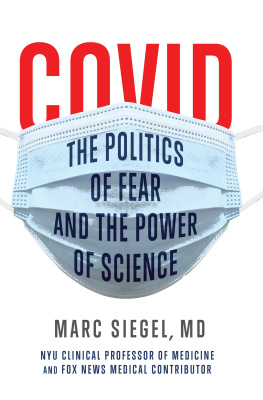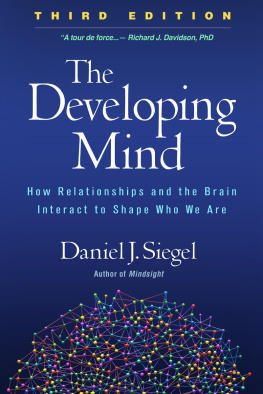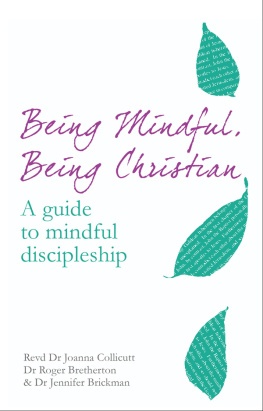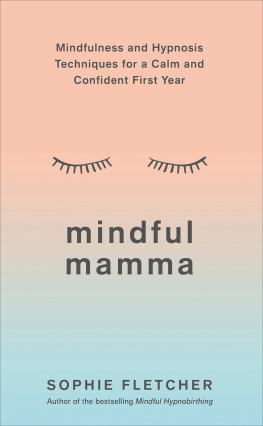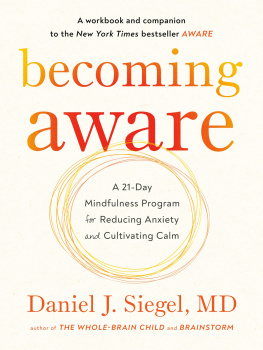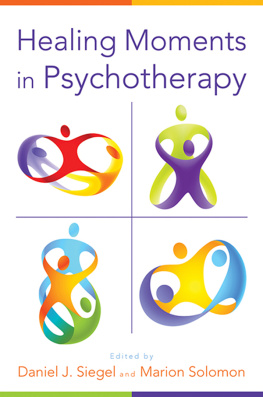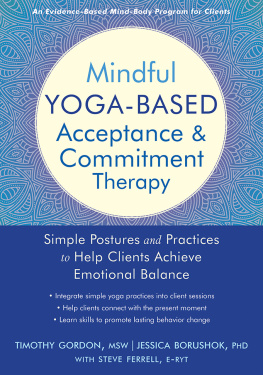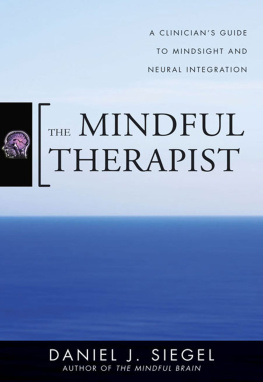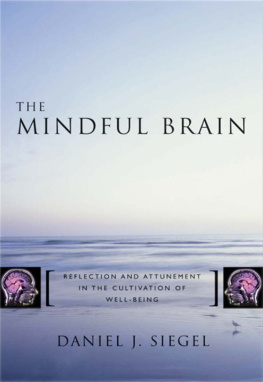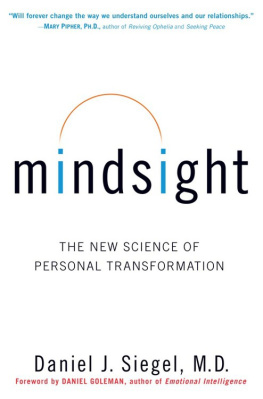DANIEL J. SIEGEL, MD
THE MINDFUL THERAPIST
A Clinicians Guide to Mindsight and Neural Integration

W. W. NORTON & COMPANY
New York London
All illustrations are the property of the author, unless noted otherwise. To contact the author, please visit mindsightinstitute.com.
Copyright 2010 by Mind Your Brain, Inc.
All rights reserved
For information about permission to reproduce selections from this book, write to Permissions, W. W. Norton & Company, Inc., 500 Fifth Avenue, New York, NY 10110
Library of Congress Cataloging-in-Publication Data
Siegel, Daniel J., 1957
The mindful therapist: a clinicians guide to mindsight and neural integration / Daniel J. Siegel.1st ed.
p.; cm.(Norton series on interpersonal neurobiology)
Includes bibliographical references.
ISBN: 978-0-393-70645-1
ISBN: 978-0-393-70658-1 (e-book)
1. Mindfulness-based cognitive therapy. I. Title. II. Series: Norton series on interpersonal neurobiology.
[DNLM: 1. Psychotherapymethods. 2. Awareness. 3. Brainphysiology. 4. Mind-Body Relations (Metaphysics) 5. Professional-Patient Relations. WM 420
S5705 2010]
RC489.M55S54 2010
616.891425dc22
2009049383
W. W. Norton & Company, Inc., 500 Fifth Avenue, New York, N.Y. 10110
www.wwnorton.com
W. W. Norton & Company Ltd., Castle House, 75/76 Wells Street, London W1T 3QT
To my parents, Sue and Marty,
and my brother, Jason:
Thank you for growing me up in Carthay Circle
and inspiring me to dream
of triangles of well-being and
planes of possibility
CONTENTS
ACKNOWLEDGMENTS
A s my wife says, this work has taken a lifetime to develop before I ever placed fingers on keyboard to enable the words and the worlds to be expressed here. In this way, I am also grateful for a lifetime of support from many wonderful people who have graced this journey with their presence. From the beginning with my mother, father, and brother, I have been encouraged to think on my feet and to not take anything for granted. My friends in my youth, Jon Fried and Yves Marton, have likewise nourished this propensity to question everything with a curious mind. As I grew through my formal education, elementary, junior high, high school, and college teachers have variously inspired and pushed me to look beyond what was in plain view. Through medical school, Leston Havens was a mentor in this same vein; and in psychiatry training through my clinical and research years, Gordon Strauss, Joel Yager, Denny Cantwell, Robert Stoller, Donald Schwartz, Regina Pally, Marian Sigman, Chris Heinicke, and Robert Bjork all contributed to my growth as clinician and academician. I thank them all. Now, in my work at UCLA, Sue Smalley, Diana Winston, Marv Belzer, Susan Kaiser-Greenland, and the gang at the Mindful Awareness Research Center along with the assembly of wonderful thinkers at the Foundation for Psychocultural Research/UCLA Center for Culture, Brain and Development continue to stimulate my creative thinking about our human lives. My close connections with Diane Ackerman, Lou Cozolino, Jon Kabat-Zinn, Jack Kornfield, Allan Schore, and Rich Simon continue to offer me sustenance, as I feel blessed by their wisdom and our relationships. At the Mindsight Institute, Stephanie Hamilton, Eric Bergemann, Tina Bryson, Adit Shah, and Aubrey Siegel make working at the interface of ideas, interventions, and education in the world of compassion and brain science a wonderful adventure. Stephanies husband, Chris, was a tremendous help in putting my ideas of the plane of possibility into visual form. The other drawings were done by MAWS & Company, for which I am much appreciative. Deborah Malmud, Kristin Holt-Browning, and Vani Kannan have been a pleasure to work with at W. W. Norton and Gabe Eckhouse has been helpful in the final proof editing of the manuscript. At home, my two children have inspired me to be present as they move forward in their own journeys, exploring their passions and bringing me great joy and wonderment with their growth. And, as always, my wife Caroline Welch remains a steady and attuned partner whose support, advice, and role modeling continue to nurture my life and my work.
INTRODUCTION
Y ou and I are the subjects of this book. I invite you to join with me in the chapters that follow, written as a conversation between two clinicians, as we explore the nature of how we connect with others in healing relationships. This dialogue is organized in both breadth and depth with the goal of being useful for experienced practitioners, as well as for those new to their education in the healing arts.
Research suggests that our presence as medical or mental health clinicians, the way we bring ourselves fully into connection with those for whom we care, is one of the most crucial factors supporting how people healhow they respond positively to our therapeutic efforts. Whatever the individual approach or clinical technique employed, the therapeutic relationship is one of the most powerful determinants of positive outcome in a range of studies of psychotherapy (see Norcross, Beutler, & Levant, 2005).
In this book well be addressing these findings by asking ourselves this basic question: Why is our presencenot just the interventions we offer or the theoretical stance we takethe most robust predictor of how our patients respond? What is presence, and how can we cultivate this in ourselves? In The Mindful Therapist , we will be exploring the possible answers to these fundamental questions that emerge from a scientific journey into the art of healing. In this Clinicians Guide to Mindsight and Neural Integration , well be diving deeply into a professional view of the fundamental way that we sense and shape energy and information flow in our livesa process called mindsight . With mindsight, we are given the tools of empathy and insight to more deeply sense and understand ourselves and others within relationships, the process of our ever-changing brains, and even how our mind itself functions. This inner clarity can help us to modify the flow of energy and information within our own lives and in our interactions with others in a very specific manner. The power to move our lives from nonintegrated states of rigidity or chaos toward the more flexible and harmonious flow of an integrated system is what we create when we intentionally cultivate neural integration in our lives. This creation reveals how we can be intentional in nurturing, first, the differentiation of aspects of our relationships and our nervous system, and then linking those separate elements to one another to cultivate integration. In essence, we use mindsight to foster neural integration as we move our lives toward health.
Now more than ever we can harness the insights from scientific research to enhance our own effectiveness as clinicians in helping to cultivate both the objective health and subjective well-being of others. Physicians who are more empathic, for example, have patients who heal faster from the common cold and have more robust immune functions to fight infections (see Rakel et al., 2009). And studies also reveal how becoming more attuned to ourselves and others with mindfulness practice can improve our own sense of well-being and our attitudes toward our patients. Learning to be mindful has been demonstrated in research with primary care physicians to prevent burnout and promote positive attitudes toward patients, as it bolsters resilience and well-being in the challenge of caring for others (see Krasner et al., 2009). What these studies share in common is the notion that our presencewith others and with ourselvespromotes empathy and self-compassion, which both cultivates well-being in our mental lives and in our bodily health. And so this conversation will be focusing upon two important dimensions of understanding: the scientific knowledge derived from various disciplines of research and the direct subjective insights attained by immersion in personal experience through focused exercises, which we will be exploring throughout this book.



